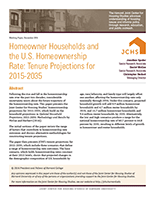Homeowner Households and the U.S. Homeownership Rate: Tenure Projections for 2015-2035
Following the rise and fall in the homeownership rate over the past two decades, considerable uncertainty exists about the future trajectory of the homeownership rate. This working paper presents the Joint Center for Housing Studies' homeownership projections for 2015-2035, which builds on the projections in Updated Household Projections, 2015-2035: Methodology and Results by McCue and Herbert (2016).
The initial sections of this paper review the range of factors that contribute to homeownership rate outcomes and discuss alternative methodologies for constructing tenure projections. The paper then presents JCHS's tenure projections for 2015-2035, which include three scenarios that define a range of homeownership rate outcomes. The base scenario, which holds homeownership rates constant at their 2015 levels, shows that projected changes in the demographic composition of U.S. households by age, race/ethnicity, and family type will largely offset one another, affecting the homeownership rate only minimally through 2035. Under this scenario, projected household growth will add 8.9 million homeowner households and 4.7 million renter households by 2025, and 15.7 million homeowner households and 9.4 million renter households by 2035. Alternatively, the low and high scenarios produce a range for the national homeownership rate of 60.7 percent to 64.8 percent by 2035, resulting in different levels of growth in homeowner and renter households.

